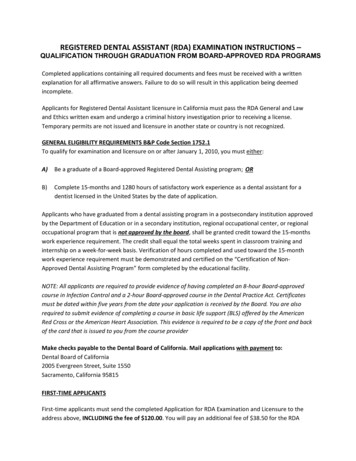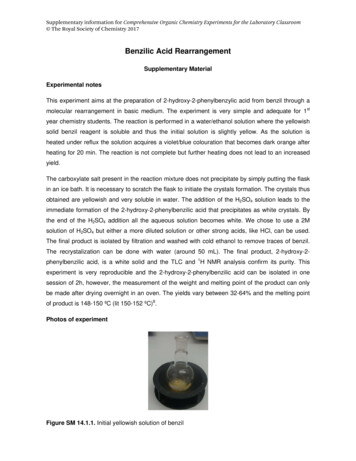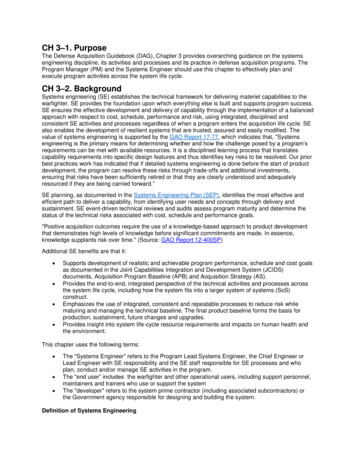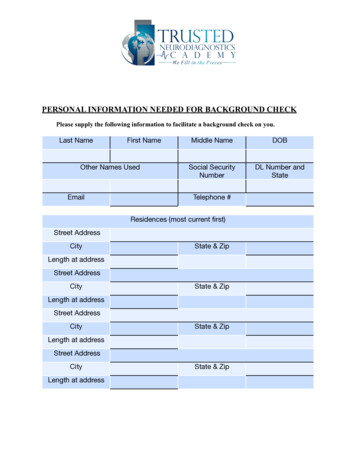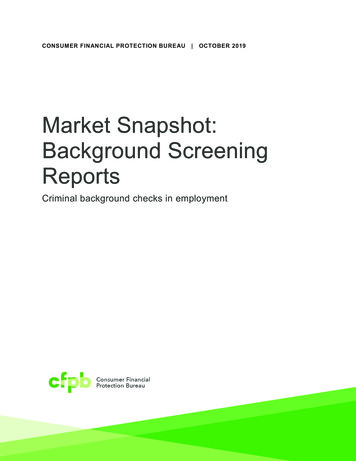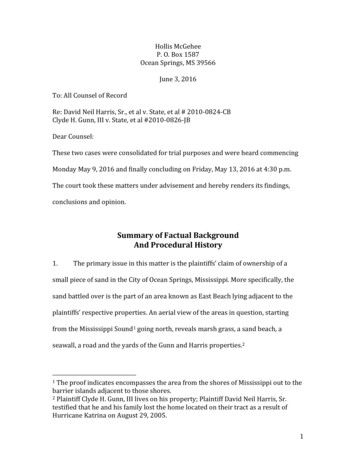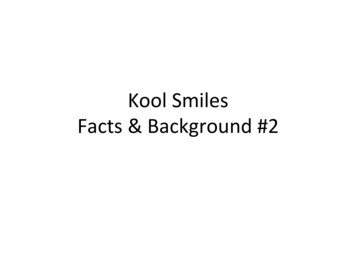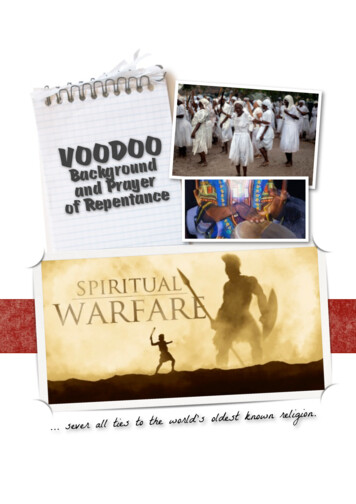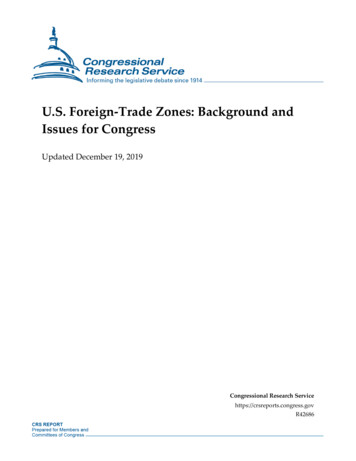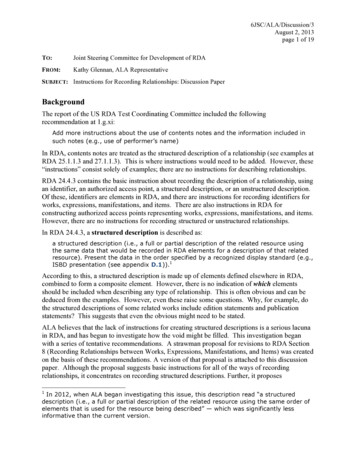
Transcription
6JSC/ALA/Discussion/3August 2, 2013page 1 of 19T O:Joint Steering Committee for Development of RDAFROM:Kathy Glennan, ALA RepresentativeSUBJECT: Instructions for Recording Relationships: Discussion PaperBackgroundThe report of the US RDA Test Coordinating Committee included the followingrecommendation at 1.g.xi:Add more instructions about the use of contents notes and the information included insuch notes (e.g., use of performer’s name)In RDA, contents notes are treated as the structured description of a relationship (see examples atRDA 25.1.1.3 and 27.1.1.3). This is where instructions would need to be added. However, these“instructions” consist solely of examples; there are no instructions for describing relationships.RDA 24.4.3 contains the basic instruction about recording the description of a relationship, usingan identifier, an authorized access point, a structured description, or an unstructured description.Of these, identifiers are elements in RDA, and there are instructions for recording identifiers forworks, expressions, manifestations, and items. There are also instructions in RDA forconstructing authorized access points representing works, expressions, manifestations, and items.However, there are no instructions for recording structured or unstructured relationships.In RDA 24.4.3, a structured description is described as:a structured description (i.e., a full or partial description of the related resource usingthe same data that would be recorded in RDA elements for a description of that relatedresource). Present the data in the order specified by a recognized display standard (e.g.,ISBD presentation (see appendix D.1)).1According to this, a structured description is made up of elements defined elsewhere in RDA,combined to form a composite element. However, there is no indication of which elementsshould be included when describing any type of relationship. This is often obvious and can bededuced from the examples. However, even these raise some questions. Why, for example, dothe structured descriptions of some related works include edition statements and publicationstatements? This suggests that even the obvious might need to be stated.ALA believes that the lack of instructions for creating structured descriptions is a serious lacunain RDA, and has begun to investigate how the void might be filled. This investigation beganwith a series of tentative recommendations. A strawman proposal for revisions to RDA Section8 (Recording Relationships between Works, Expressions, Manifestations, and Items) was createdon the basis of these recommendations. A version of that proposal is attached to this discussionpaper. Although the proposal suggests basic instructions for all of the ways of recordingrelationships, it concentrates on recording structured descriptions. Further, it proposes1In 2012, when ALA began investigating this issue, this description read “a structureddescription (i.e., a full or partial description of the related resource using the same order ofelements that is used for the resource being described” — which was significantly lessinformative than the current version.
6JSC/ALA/Discussion/3August 2, 2013page 2 of 19instructions for two specific types of relationships — contents notes and accompanying materialstatements — as examples of how these basic instructions might be extended in order to providespecific guidance.ALA has begun to analyze the implications of the recommendations, and to apply them to theexamples of structured descriptions in Section 8. This work is still in progress, but ALA wouldlike to put forward our tentative recommendations for comment and discussion by the JointSteering Committee and the RDA community in general.Tentative RecommendationsThe following tentative recommendations served as the basis for the strawman proposal and aresubmitted here for comment and discussion by the JSC.1. Instructions on recording relationships as structured descriptions should be addedto RDA chapters 24–28. In the strawman proposal, this recommendation has beenextended to include instructions on recording relationships as an identifier, authorizedaccess point, or an unstructured description.2. A structured description is made up of appropriate elements defined elsewhere inRDA, recorded following the instructions for recording those elements, andcombined into a single composite element. This basic guideline is now stated in RDA24.4.3.3. Such a composite element should include an appropriate relationship designatorfrom appendix J, in order to specify the nature of the relationship.4. A structured description of a related entity should consist of elements that recordattributes of that entity. In other words, a structured description of a Related Work(RDA 25.1) should consist of work attributes such as Preferred Title, whereas thestructured description of a Related Manifestation (RDA 27.1) should consist ofmanifestation elements such as Title Proper and Statement of Responsibility.Discussion: The recommendation above was a first attempt to answer the question,Which elements are appropriate for inclusion in a structured description?This question, and this tentative recommendation, has turned out to be the mostproblematic aspect of the strawman proposal. First, it is clear that no such principle wasapplied in the current examples in Section 8, which routinely mix work, expression, andmanifestation elements. It is also sometimes difficult to provide a meaningful descriptionwithout mixing WEMI levels. Further discussion on this issue is included below under“Issues Raised by the Strawman Proposal”.5. There should be provision for the inclusion of instructions for dealing with thedescription of specific types of related entities. The strawman proposal includesinstructions for Content of the Work (25.1.1.3.2.1); Contents of the Manifestation(27.1.1.3.2.1); Host for the Manifestation (27.1.1.3.2.2); and Accompanying
6JSC/ALA/Discussion/3August 2, 2013page 3 of 19Manifestation (27.1.1.3.2.3). These are intended both as a general template for providingsuch specific instructions and as possible instructions for dealing with two categories thathave already caused difficulties in the development and implementation of RDA.The inclusion of such instructions would not only provide useful guidance to catalogers,but would provide granularity that would facilitate mapping to standards such as ISBDand MARC 21. Such instructions ought to include captions and to be included in theRDA outline and index, making them easier to find.It is difficult to know how far to go. Potentially there might be a set of instructions forevery relationship designator in Appendix J. While most of them do not seem to warrantspecific instructions, many of them might.6. The instructions for contents note for manifestations should say to record the titleproper and statement of responsibility for each part of the manifestation beingdescribed and, if desired, other elements that relate to the parts (such as extent,playing time, or names of performers).The instructions for contents notes for works should say to record the preferred titleof the work. Beyond that, it is not clear what might be appropriate.The instructions for contents notes for expressions present particular difficulties,given that RDA explicitly decided not to include a Title of Expression element. It isdifficult to see how a contents note could be formulated that does not duplicate theauthorized access point — something, that as a matter of principle, we have sought toavoid.In regard to contents notes for manifestations, ISBD supports combining elements at boththe expression and manifestation levels (e.g., ISBD 7.7.1, “For audiovisual resources, ifthe durations of individual works are given in the contents note, they are placedimmediately after the bibliographic description.”).See further comments below under “Issues Raised by the Strawman Proposal”.7. The instruction for accompanying material statements should say to record theExtent of the accompanying manifestation, together with other identifyinginformation (such as Dimensions), as appropriate. This would allow such a structureddescription to qualify as an ISBD accompanying material statement and to be recorded inMARC 21 field 300 subfield e.Issues Raised by the Strawman ProposalIn the course of creating and evaluating the strawman proposal, a number of issues arose. Wereport those here for information. Although we welcome comments and trust that suchcomments will inform our future work, we believe that the main focus of JSC discussion shouldbe on the recommendations presented above.1. The basic guideline is to record information as part of a structured description followingthe instructions for recording that element. This would include transcribing data such asstatements of responsibility. This has not always been done in our examples (particularly
6JSC/ALA/Discussion/3August 2, 2013page 4 of 19those for related works and related expressions), because (a) we wanted to avoid simplyrecreating the authorized access point, and (b) we were not sure that the full element wasalways needed for identification. Therefore, the preferred name of a creator orcontributor (for example) is presented in a variety of ways in the examples. We are stilllooking for the right balance here.2. We were constantly faced with the inevitable question: Which elements should beincluded in a structured description? On the one hand, some of our examples did notinclude elements sufficient to distinguish the related entity from other entities. For anauthorized access point, these elements would be core, but we were not sure that this wasrequired for a structured description. On the other hand, some of our examples includeelements that are not required to uniquely identify the related entity. These would not beincluded in an authorized access point, but we were not sure that this same criterionapplied to a structured description. In general, we feel that the usefulness of suchinformation should be left to the individual cataloger’s judgment of the particular case athand.3. The reference in RDA 24.4.3 to “the order specified by a recognized display standard(e.g., ISBD presentation )” and the consistent use of ISBD punctuation in the examples(as specified in the fourth paragraph of RDA 0.10) was cause for concern. Not only isRDA meant to be output-neutral, but the only “recognized display standard” for work andexpression elements is RDA Appendix E, which applies specifically to access points. Inthis case, we chose to present our examples for related works and expressions with aspace-colon-space between each separate element in the structured description. This maynot be the ultimate answer, but for now it serves to focus attention on the elementsrecorded, not on how they are presented.4. As noted in Recommendation #4 above, the basic guideline to use only work elements ina structured description of a related work (etc.) was particularly difficult to apply to theexamples in the strawman proposal. We are aware that this has come up as a generalissue about examples in RDA. There is a tendency to be less than rigorous in this regardbecause we are currently working in an environment of composite descriptions supportedby ISBD and encoded in MARC 21 that routinely mix attributes of work and expressioninto the description of the manifestation. This informed the format of our added contentsnote example in 27.1.1.3.2.1 below. However, we will not be working in thisenvironment forever, and Deborah Fritz’s work with the RIMMF software (whichmaintained separate, linked descriptions of each entity) is encouraging us to be morerigorous about separating WEMI attributes.5. Given that many specific relationships can apply to more than one WEMI entity, it seemsappropriate to offer guidance about choosing which to apply. Our work on contents notesdoes indicate that the distinction between Contents of the Work and Contents of theManifestation cannot easily be based on any distinction between different sorts of parts,but (at least in our tentative recommendation) should be based on what elements areneeded to identify each part.It is difficult to see how it is possible to record a structured description of the Contents ofthe Expression that does not replicate the authorized access point. If the instruction is to
6JSC/ALA/Discussion/3August 2, 2013page 5 of 19use the Preferred Title rather than the Title Proper as the basis for a structured descriptionof the Contents of the Work, that would limit the utility of recording such a structureddescription. We included the Tolkien example here because the components of a trilogyseem to be appropriate to record at the work level and to record using the preferred title;however, even here, those titles are most informative only for English-languageexpressions. In most cases, it would seem appropriate to give contents notes for themanifestation, using the Title Proper and Statement of Responsibility. We are not sure,however, whether such advice should be included in the instructions or left to applicationguidelines.6. As noted in Recommendation #5 above, instructions for specific types of structureddescriptions might be added for any category of relationships. The current examplessuggest some possibilities. The relationship designators in Appendix J.2 offer a morecomplete list of possible relationships. In most cases, the elements to be used in suchdescriptions are obvious and no instructions would be needed. However, it is not clearhow far this should go. If we establish a precedent for including specific types forcontents notes, for example, do we have a principled rationale for deciding whether or notto include additional categories?Note that one consequence of including such instructions is that the captions appear in theRDA outline and the text provides keywords that will make it much easier for theseinstructions to be found in the Toolki
A strawman proposal for revisions to RDA Section 8 (Recording Relationships between Works, Expressions, Manifestations, and Items) was created on the basis of these recommendations. A version of that proposal is attached to this discussion paper. Although the proposal suggests basic instructions for all of the ways of recording relationships, it concentrates on recording structured .
